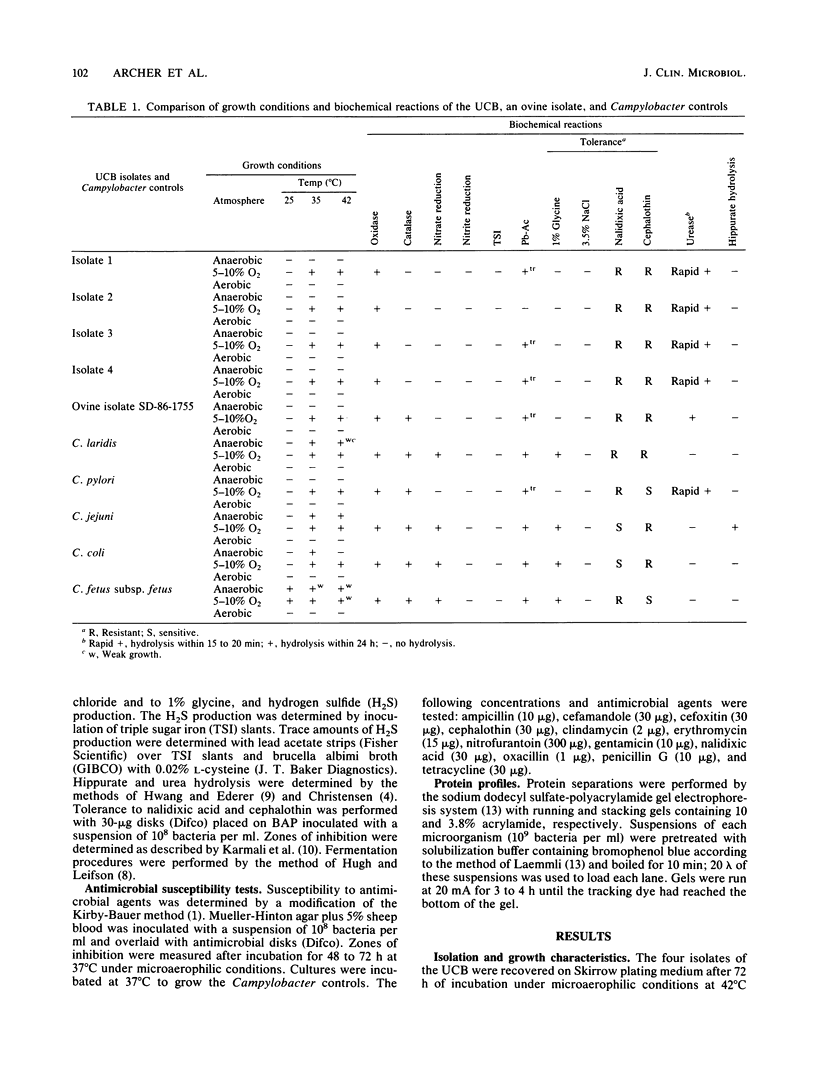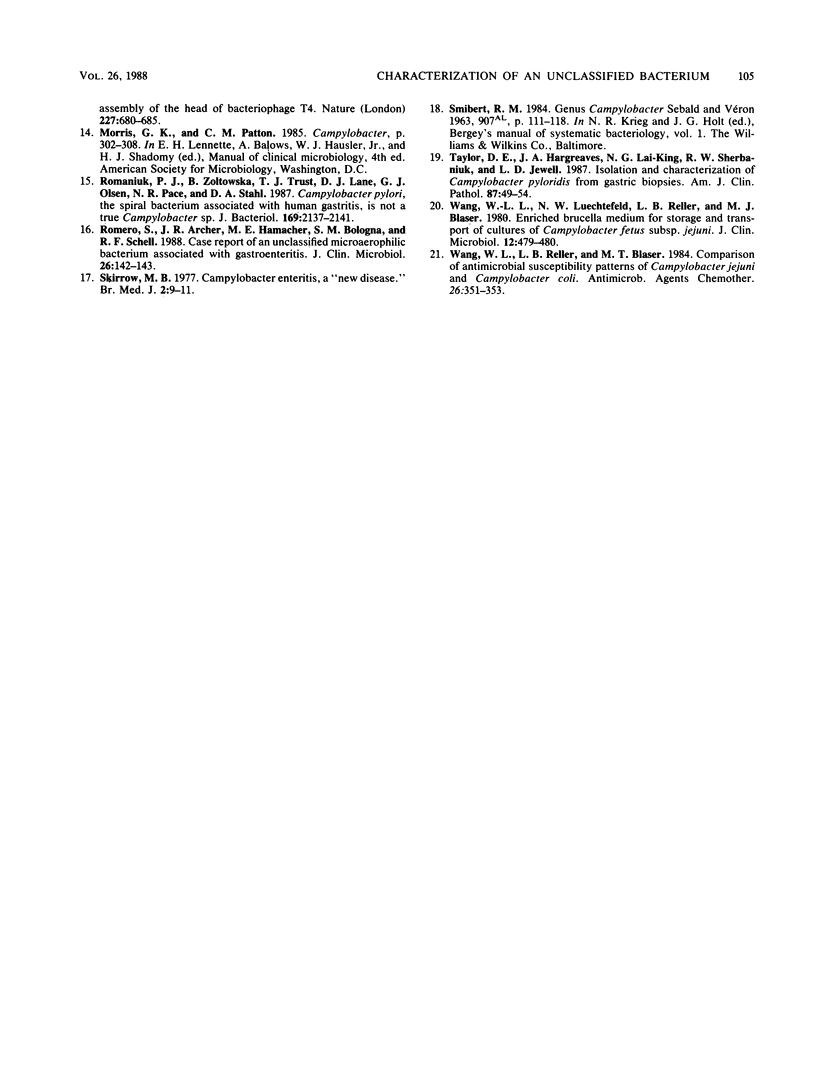Abstract
Four isolates of an unclassified microaerophilic bacterium resembling Campylobacter species were characterized by growth requirements, microscopic examination, biochemical characteristics, antimicrobial susceptibility tests, and protein profile analysis. The unclassified isolates were differentiated from Campylobacter jejuni, Campylobacter coli, Campylobacter fetus subsp. fetus, Campylobacter laridis, Campylobacter pylori, and an ovine isolate. The bacterium was fusiform shaped with a corrugated surface due to the presence of periplasmic fibers and had multiple bipolar flagella. Biochemically, the bacterium was separated from the Campylobacter controls by its negative catalase reaction, negative nitrate reduction, and no growth in 1% glycine. It was also resistant to ampicillin. Protein profile analysis demonstrated nine major protein bands present in the unclassified isolates that were absent in the Campylobacter controls. The bacterium also differed from the ovine isolate by its negative catalase reaction, rapid urea hydrolysis, and susceptibility to clindamycin, erythromycin, and tetracycline. Our results showed that the unclassified bacterium was distinct from the recognized Campylobacter species.
Full text
PDF




Images in this article
Selected References
These references are in PubMed. This may not be the complete list of references from this article.
- BAUER A. W., PERRY D. M., KIRBY W. M. Single-disk antibiotic-sensitivity testing of staphylococci; an analysis of technique and results. AMA Arch Intern Med. 1959 Aug;104(2):208–216. doi: 10.1001/archinte.1959.00270080034004. [DOI] [PubMed] [Google Scholar]
- Bryner J. H., Ritchie A. E., Pollet L., Kirkbride C. A., Collins J. E. Experimental infection and abortion of pregnant guinea pigs with a unique spirillum-like bacterium isolated from aborted ovine fetuses. Am J Vet Res. 1987 Jan;48(1):91–95. [PubMed] [Google Scholar]
- Christensen W. B. Urea Decomposition as a Means of Differentiating Proteus and Paracolon Cultures from Each Other and from Salmonella and Shigella Types. J Bacteriol. 1946 Oct;52(4):461–466. doi: 10.1128/jb.52.4.461-466.1946. [DOI] [PMC free article] [PubMed] [Google Scholar]
- Goodwin C. S., Armstrong J. A., Marshall B. J. Campylobacter pyloridis, gastritis, and peptic ulceration. J Clin Pathol. 1986 Apr;39(4):353–365. doi: 10.1136/jcp.39.4.353. [DOI] [PMC free article] [PubMed] [Google Scholar]
- Goodwin C. S., Blake P., Blincow E. The minimum inhibitory and bactericidal concentrations of antibiotics and anti-ulcer agents against Campylobacter pyloridis. J Antimicrob Chemother. 1986 Mar;17(3):309–314. doi: 10.1093/jac/17.3.309. [DOI] [PubMed] [Google Scholar]
- HUGH R., LEIFSON E. The taxonomic significance of fermentative versus oxidative metabolism of carbohydrates by various gram negative bacteria. J Bacteriol. 1953 Jul;66(1):24–26. doi: 10.1128/jb.66.1.24-26.1953. [DOI] [PMC free article] [PubMed] [Google Scholar]
- Hwang M. N., Ederer G. M. Rapid hippurate hydrolysis method for presumptive identification of group B streptococci. J Clin Microbiol. 1975 Jan;1(1):114–115. doi: 10.1128/jcm.1.1.114-115.1975. [DOI] [PMC free article] [PubMed] [Google Scholar]
- Karmali M. A., De Grandis S., Fleming P. C. Antimicrobial susceptibility of Campylobacter jejuni and Campylobacter fetus subsp. fetus to eight cephalosporins with special reference to species differentiation. Antimicrob Agents Chemother. 1980 Dec;18(6):948–951. doi: 10.1128/aac.18.6.948. [DOI] [PMC free article] [PubMed] [Google Scholar]
- Kirkbride C. A., Gates C. E., Collins J. E. Abortion in sheep caused by a nonclassified, anaerobic, flagellated bacterium. Am J Vet Res. 1986 Feb;47(2):259–262. [PubMed] [Google Scholar]
- Kirkbride C. A., Gates C. E., Collins J. E., Ritchie A. E. Ovine abortion associated with an anaerobic bacterium. J Am Vet Med Assoc. 1985 Apr 15;186(8):789–791. [PubMed] [Google Scholar]
- Laemmli U. K. Cleavage of structural proteins during the assembly of the head of bacteriophage T4. Nature. 1970 Aug 15;227(5259):680–685. doi: 10.1038/227680a0. [DOI] [PubMed] [Google Scholar]
- Romaniuk P. J., Zoltowska B., Trust T. J., Lane D. J., Olsen G. J., Pace N. R., Stahl D. A. Campylobacter pylori, the spiral bacterium associated with human gastritis, is not a true Campylobacter sp. J Bacteriol. 1987 May;169(5):2137–2141. doi: 10.1128/jb.169.5.2137-2141.1987. [DOI] [PMC free article] [PubMed] [Google Scholar]
- Romero S., Archer J. R., Hamacher M. E., Bologna S. M., Schell R. F. Case report of an unclassified microaerophilic bacterium associated with gastroenteritis. J Clin Microbiol. 1988 Jan;26(1):142–143. doi: 10.1128/jcm.26.1.142-143.1988. [DOI] [PMC free article] [PubMed] [Google Scholar]
- Skirrow M. B. Campylobacter enteritis: a "new" disease. Br Med J. 1977 Jul 2;2(6078):9–11. doi: 10.1136/bmj.2.6078.9. [DOI] [PMC free article] [PubMed] [Google Scholar]
- Taylor D. E., Hargreaves J. A., Ng L. K., Sherbaniuk R. W., Jewell L. D. Isolation and characterization of Campylobacter pyloridis from gastric biopsies. Am J Clin Pathol. 1987 Jan;87(1):49–54. doi: 10.1093/ajcp/87.1.49. [DOI] [PubMed] [Google Scholar]
- Wang W. L., Luechtefeld N. W., Reller L. B., Blaser M. J. Enriched brucella medium for storage and transport of cultures of Campylobacter fetus subsp. jejuni. J Clin Microbiol. 1980 Sep;12(3):479–480. doi: 10.1128/jcm.12.3.479-480.1980. [DOI] [PMC free article] [PubMed] [Google Scholar]
- Wang W. L., Reller L. B., Blaser M. J. Comparison of antimicrobial susceptibility patterns of Campylobacter jejuni and Campylobacter coli. Antimicrob Agents Chemother. 1984 Sep;26(3):351–353. doi: 10.1128/aac.26.3.351. [DOI] [PMC free article] [PubMed] [Google Scholar]





